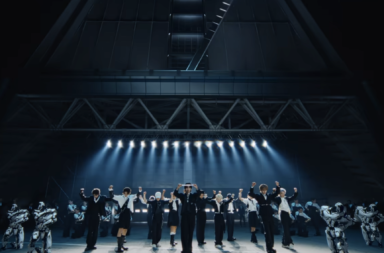
We’ve covered songs of the decade and had a retrospective on how Korean hip-hop has evolved, so it only makes sense that we also talk about music videos. MVs are an effective marketing tactic, one that uses a visual medium to sell to viewers a song. The MV is also a hallmark of K-pop, and they are getting increasingly creative and diverse in the message.
But MVs come in different types, and it would be unjust to pigeonhole the myriad of choices in one list. For this series of the Seoulbeats Decade in Review, we have split the MVs into three types: performance, narrative, and aesthetic/symbolism-focused. In this list, we concentrate on the music videos that are dominated by choreography shots and body language acting to evoke a feeling or mood.
2010
Writer: Kaitlin
Shinee, “Lucifer”
The beginning of this decade in K-pop kicked off with a trend of dark, dramatic, performance-driven videos, such as SNSD’s “Run Devil Run,” Beast’s “Breath,” SS501’s “Love Ya,” and 2PM’s “Heartbeat.” But the stand-out of the entire year was Shinee’s “Lucifer.”
The outlandish styling is eye-catching, to say the least. And the fleeting wisp of white CGI smoke the members interact with is a simple set-up that allows them to act out their conflicting emotions.
But the dance is truly the star of the MV thanks to some smart editing tricks. The quick cuts and flashing fluorescent lights create a frenetic, disorienting energy that helps convey the dazed and dazzled mental state portrayed in the song’s lyrics.
Air-swiping sound effects added on top of the track enhances the crispness of Shinee’s dance moves. Long, wide, uncut shots of the members dancing build drama and highlight Shinee’s cohesion and control. This is contrasted by more staccato, on-beat cuts during the chorus, which contribute to the song’s driving momentum and enhance the key points of the choreography on each major beat.
Shinee are some of the strongest performers in K-pop, and this MV successfully amplifies their strengths.
2011
Writer: Gina
miss A, “Goodbye Baby”
To start off, there were many strong contenders for this year — from U-kiss’ “Neverland” to Kara’s “Step” and even Hyuna’s “Bubble Pop.” This was also the year Wonder Girls returned with “Be My Baby”, and the year T-ara meshed numerous techniques into one for their choreography in “Cry Cry.”
However, miss A’s “Goodbye Baby” takes the cake for their clever merging of plot and dance. For most MVs, plot and choreography scenes remain separate from one another. Dance breaks are often considered a shift away from the plot, as well as solo shots. But here, we see miss A dance around the very man that has done them wrong, as his tank is slowly but surely filled with water. The plot is then combined with individual shots, with each one of them hinting at a different relationship the man has had with the members.
The outcome is a unique, slightly comical tension as we watch the water rise, while the girls confidently dance onstage. By the end, viewers await what happens, and are met with the man still laughing, hinting that maybe nothing has changed.
2012
Writer: Kaitlin
TVXQ, “Catch Me”
Psy’s “Gangnam Style” was arguably the dance of the year in 2012, if not the K-pop dance of the decade. But in terms of MVs that not only captured but also elevated an epic performance, TVXQ’s “Catch Me” is the year’s shining example. Quite literally, as the stark black, white and gray video is punctuated with gleaming metallics.
The futuristic sets are sparse save for flashing lights, fog, and jagged structures for Yunho and Changmin to pose on. Along with these neutral backdrops, the members and their backup dancers are styled in fairly plain black and white ensembles except for the silver gauntlets that cover their hands and forearms. These accessories highlight the choreography’s dramatic shapes and formations, including a hypnotizing snakelike wave and a massive flexing arm formed when everyone links their forearms together.
The drama and intensity of the dance doesn’t lag during the individual choreography moments thanks to the use of rapid, on-beat cuts as well as shots of the number performed on a floor covered with water. Simple stomps and sweeps of the leg send water flying. The styling, sets, and editing all come together to magnify this larger-than-life performance.
2013
Writer: Qian
Block B, “Very Good”
Let’s get one thing straight: if this was purely judged on choreography, EXO would have won this in a heartbeat with “Growl”. But this is judged on “performance”, and Block B delivers lightning in a bottle with “Very Good”.
“Very Good” is organised chaos: from the lackadaisical choreography that pops when it needs to — Jaehyo dancing alone in the vault — to the tongue-in-cheek references to their criticisms — Kyung and Zico tauntingly recreate elements of Big Bang MVs — to all the members acting completely unhinged as they cause havoc in the bank, “Very Good” is better than very good; it’s almost perfect. It’s an exhilarating celebration of their faults and strengths, it’s a story of their triumph over their former company, it’s big, brassy fun. If “Very Good” has proven anything, it’s that with Block B, there’s no such thing as going over-the-top.
2014
Writer: Gina
GD & Taeyang, “Good Boy”
The spinning camerawork. A huge crowd of party dancers. The neon lighting. These are just some of the elements that make this MV iconic and worthy of achieving a “YouTube Music Moment.” In simpler terms, this MV is something only these two could pull off with ease – and have fun doing so.
Together, GD and Taeyang emit the perfect balance between being laid back and having fun, reflected in the choreography and how they make the best use of their surroundings. From the moment the two walk in, they’re perfectly meshed into the party atmosphere and stand out from the crowd through their own distinct charms. In these ways, visual aesthetics and performance merge to create a memorable (and colorful) MV.
Moreover, the settings of their performance enable them to roam around and dance freestyle beyond their choreo whenever they wish – further highlighting their already proclaimed musical freedom that has led to this EDM masterpiece. Ultimately, “Good Boy” leaves me wondering how lit it might’ve been if the unit released further works together.
2015
Writer: Qian
Seventeen, “Mansae”
In retrospect, 2015 was especially stacked when it comes to performances. BTS shot into the mainstream with “Dope”, Oh My Girl gave us a cult classic with “Closer”, but Seventeen gave us “Mansae”: a flirtatious, rambunctious track that not only served as the basis for their future performances but also gave us one of the best, most creative choreographies K-pop had ever seen.
S. Coups lowering down a drawbridge to reveal Vernon. Re-enacting a basketball game in the middle of a song. The leapfrogging. The waving of the arms in celebration at the very end. These are just some of the elements that make this performance one to remember. In the hands of a lesser group, these elements would all be considered gimmicky, but Seventeen manages to tie it all together with their dynamism, their charm, their razor-sharp moves, and this relentless energy they possess in spades. It’s joyous, it’s clean, it’s a performance I go back to again and again; with “Mansae”, Seventeen makes the case that sometimes, just sometimes, more is more.
2016
Writer: Aaron
Exo, “Monster”
From the opening dance sequence, which had each member’s body movements informing the movement of the camera work, to the interlinked X formation in the first chorus section, “Monster” not only set the bar high for dance performances in K-pop after its release. It also combined all the stylistic choices that have gone on to define what an Exo MV looks like.
Camera work being dictated by each member’s movements was originally explored as a concept in Exo-K’s “Overdose”, but on “Monster” it is far more subtly mastered. Its narrative runs are intertwined with the dance performance to further convey the mood of the MV. This format of narrative mixed with dance performance has remained all the way up to their latest MV release, “Obsession”.
This gritty, aggression filled medley of movement found on “Monster” stands as the growing up point between the boyish charm of MVs such as “Growl” and “Call me Baby” to their now darker look. Finally, “Monster”’s PAK also allowed Exo to remain relevant in a year that saw an explosion of new major K-pop groups and shifting trends within the K-pop format.
2017
Writer: Kalia
Taemin, “Move”
“Move” is in a league of its own. Everything about the MV acts as a testament to what makes Taemin such a dynamic performer. The aesthetic choices are subtle but intriguing; the camera switches back and forth from a grainy, almost CCTV-like filter to sharp contrasts and cool tones, going from direct eye contact to a third-person POV, distortions covering faces. They work together to cast a dark and mysterious vibe over the project, while still keeping the bulk of attention on his performance.
Whether he was flanked by the incredibly talented Koharu or his back-up dancers, there isn’t a second of the MV where he isn’t commanding all eyes on him. This was my only choice of a stand-out performance this year, because of how Taemin is able to demand attention from start to finish.
As a whole, “Move” creates this sense of bridging old and new when it comes to how sexuality and gender intersect. Taemin and his team were able to create a body of work that introduced a different take of what it means to be sexy in K-Pop.
2018
Writer: Gina
BTS V, “Intro: Singularity”
This masterpiece is my only choice for 2018. Besides the artistic and innovative choreography; the beautiful yet delicate scenery for V’s profile shots; and the haunting mood prevalent in the MV, the creativity in capturing his performance was also noteworthy. While the backgrounds for V’s own shots included elements of flowers, water, and monotony (black and white), choreography shots solely relied on color and lighting. These two visual elements were highly utilized to set moods for specific parts of their performance, such as the scene of V dancing while soaked in red that highly contrasts his performance with blue or white lighting.
While the more “box-like” setting could remind viewers of second-generation MVs, that notion is quickly altered once V dances with unanticipated props. The idea behind including floating white masks and dressed coat hangers is truly something else – symbolic and distinct, it is solely for “Singularity.” It further helps that the camera captures every little move, including profile and scenic shots, only to maintain visual balance. Everything from camera work to aesthetics and mood were perfect in highlighting V’s successful solo.
2019
Writer: Denise
TRCNG, “Missing”
The music video for “Missing” is dominated by its choreography, and for good reason. Having debuted in 2017, TRCNG are still criminally underrated, in particular for their outstanding dance skills. This is K-pop choreography as its best — sharp, synchronised, energetic. What’s particularly impressive is the fact that the group lacks weak links, flaunting their versatility with B-boy moves and challenging floorwork.
The way TRCNG transitions seamlessly through formations is best captured in their dance practice video, but the MV, fortunately, manages to match up to and evoke the ethereal excitement of the song. With the use of varied pacing and also its artistic choices, the non-choreography shots of the MV flow brilliantly in time with the different sections of the music, bringing out the best of its emotiveness. If there’s anything that “Missing” shows, it’s that you don’t need incredibly flashy or high-budget sets to impress and bring out the talent of your artists.
What were some of your favorite performance-based music videos of the decade? Let us know below!
(Youtube [1][2][3][4][5][6][7][8], Images via Seven Seasons, SM Entertainment)


